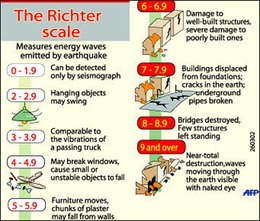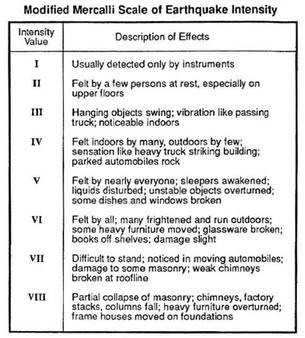OxNotes > GCSE/IGCSE Revision > GCSE Geography > Measuring and monitoring volcanic activity & eruptions
Simple explanation of measuring volcanoes & earthquakes:
There are many different methods to measure volcanoes and
earthquakes. This page will explain the main types that measure and monitor
these natural hazards.
Volcanic Explosivity Index (VEI): Measuring volcanic eruptions
The Volcanic Explosivity Index (VEI) measures the size /
magnitude of explosive eruptions from 0 to 8. Each number is equal to ten times
the explosivity of the one before it. The VEI also accounts for ash fall,
pyroclastic flows and other substances that are ejected to the height, and
duration, of the eruption.
Richter Scale: Measuring Earthquakes

The Richter Scale measures the energy of an earthquake. The Richter scale is scientific and is usable anywhere there is an earthquake.
Mercali Scale: Measuring Earthquakes
|
The Mercali scale is different to the mathematical and more scientific Richter scale as it measures how people feel and react to the shaking of an earthquake. It speaks about the effects on human beings, which is the main concern of governments dealing with earthquakes. The Mercalli scale varies not only by the energy of the earthquake but by the nature of the surrounding landscape and the quality of the infrastructure.
The Mercali scale is only useful in populated areas. |
Related revision notes on OxNotes
‹ Back to GCSE Geography, an

